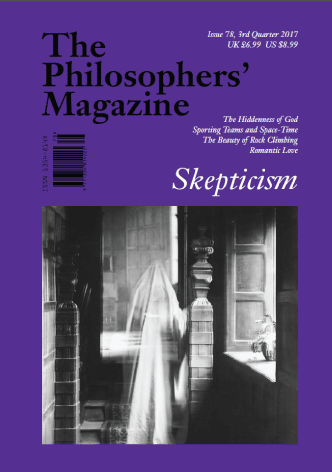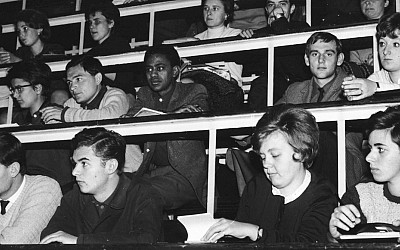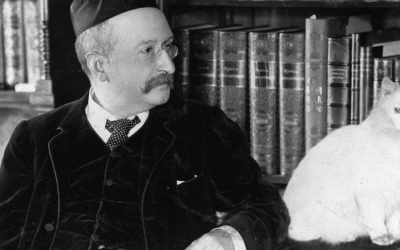Barry C. Smith argues for a collaborative approach
At times in its long history philosophy has had to concede ground to other, newer, disciplines. Physics was once known as Natural Philosophy, and the discipline we now call Psychology used to be pursued in Philosophy departments, as it was by William James in nineteenth-century Harvard.
Arguably, the emergence of generative linguistics in the twentieth century owed a large debt to semantics and formal logic as pursued in the philosophy of language and logic; and even parts of the moral sciences and practical philosophy were ceded to economics and decision theory. In each of these cases, the field of inquiry became a stand-alone discipline when it was able to circumscribe the phenomena it covered, the methods it used, and to establish its own distinctive results. At that point philosophy usually moved on, often retreating to higher ground (e.g. metaphysics) while keeping an interest in the emerging fields and their foundations.
This shift gave rise to two very different conceptions of philosophy. On the one hand, philosophy was seen as queen of the sciences, having spawned many disciplines, but still having a subject matter of its own. On the other, philosophy was seen more as a method applicable to other subjects and so giving us not philosophy, but the philosophy of…e.g. mathematics, art, perception. This led one empirically-minded American philosopher, W.V.O. Quine, to conclude that philosophy of science was philosophy enough.
It is certainly true that specialised fields, such as the philosophy of biology or the philosophy of economics, while being parasitic on those disciplines, add to them by addressing methodological and foundational issues while contributing to the interpretation of their findings. Though surely, it will be said, philosophy has its own proprietary subject matter. Doesn’t it contribute a unique form of knowledge by illuminating certain phenomena in a way that only philosophy can? And among the topics regularly taken to be uniquely amendable to a philosophical treatment are questions about the nature of beauty, conscious experience, justice and morality. Yet it is with respect to these topics that contemporary neuroscience is challenging the sovereignty of philosophy and its right to claim such phenomena are exclusively the object of philosophical inquiry. This is making some philosophers nervous.
Not only do neuroscientists believe in a science of consciousness and a science of responsibility, they have also created sub-fields, such as neuroaesthetics, neuroeconomics and, more recently, neuropolitics. In this way, they have begun to erode much of the sacred ground that philosophers believed was uniquely their domain of inquiry. If the neuroscience of choice and value, along with the neuroscience of agency, can cast light on the sphere usually reserved for ethics, where is philosophy to move to in order to secure its unique subject matter? No longer does an inward retreat to our subjective mental lives seem a safe bet since conscious experience in all its subjective glory is now seen as prime territory for neuroscientific investigation. Nothing, it seems, is out of bounds, and what’s more, current neuroscientific theorising is typically not an outgrowth of prior philosophical theorising, the way parts of psychology and physics were, originally. Instead, being a relatively new science means that neuroscience often begins from a different starting place, creating its own novel categories to characterise mental states and processes. This can be both refreshing and challenging to philosophers, making us question our taxonomy of mental states and forcing us to justify our way of carving at what philosophers take to be its joints. Philosophers often use commonsense or folk-psychological categories of beliefs and desires, wants and wishes, hopes and fears and think of conscious intentions as guiding our acts. Though from a neurobiological point of view, it is usually pointed out, following the work of Benjamin Libet, that the acts we think of ourselves as freely and consciously choosing are initiated in the motor areas of the brain before we are consciously aware of intending to do them.
Whatever one thinks of Libet’s work there is a wealth of other evidence from neuroscience that threatens to dethrone the central role we take consciousness to have in guiding our behaviour. A clear example is shown in an intriguing experiment by neuroscientists, Chris Frith and Marc Jeannerod, where participants had to draw circles on an electronic pad under the desk while they saw the circles they were drawing appearing on a computer screen in front of them. The computer manipulated the circles that appeared on the computer screen making them bigger or smaller than those drawn by the participants, and when this happened the participants simply adjusted their movements to conform to the size of the circles without being aware of what was happening. At all times they took themselves to be fully responsible for what appeared on the screen.
This experiment is just one way in which neuroscientific findings have led to revisions in our ordinary way of describing our actions. Another is the forward model of action execution proposed by Chris Frith and Daniel Wolpert. The account goes as follows. When we reach for an object, perhaps a cup in front of us, we think we are using our eyes to guide our hand to the cup. But this can’t be what is going on. Our brains would be too slow to take in the visual signals and send them to the motor areas to initiate movement. Instead, our eyes and our brains plot a course of movement through space and anticipate the sensations we will have in the arm as we move and in the hand when we reach the cup’s surface, and a copy of these sensory effects – called an efference copy – are stored in the brain and compared to the input signals we receive from our limb and our hand when we make the movement. If the signals match the predicted outcome they are cancelled out. Everything went well. When we cannot predict effects, this can lead to problems.
A busy waiter can take glasses off the tray and place them on the table, one by one. The waiter’s brain can predict how the weight will change each time a glass is lifted and adjusts accordingly. But if the customer reaches up and takes a glass off the tray, the waiter’s arm goes up and the tray can come crashing down. That’s because it is easy to predict the effects on one’s body of an action one performs oneself. It is not always possible to predict the effect of another’s action on one’s body. That’s also why you can’t tickle yourself, as Sarah-Jayne Blakemore and Chris Frith showed.
When something has gone wrong and there is no efference copy of predicted sensations of a cup lifting, i.e. no expectation of feeling one’s arm move or of experiencing the feel of the cup in one’s hand, then the action performed may not feel like one’s own, and that’s exactly what schizophrenic patients say when suffering what is known as anarchic hand syndrome. It’s also interesting to note that schizophrenic patients can tickle themselves.
What these and other findings show is that we need to revise the common sense conception of ourselves and how we operate – a conception of ourselves that philosophers often rely upon when theorising. These revisions may cut deep into our understanding of the mind and of conscious experience, and that comes hard to many philosophers who have an unshakeable faith in their starting point and the unique suitability of their methods for exploring these phenomena.
Faced with this challenge, two reactions are common. One is to hold firmly to the claim that philosophy alone can help us to understand consciousness by claiming that the subject matter will always elude material science, either by explicitly embracing dualism or some other metaphysical departure from the scientific world view, such as pansychism, or, by posing questions that only philosophy can solve. The second reaction is to concede that the problems philosophy has been interested in will eventually be replaced or solved by work in the neurosciences. This strategy was labelled neurophilosophy by Paul and Patricia Churchland. If there is any philosophy remaining outside its orbit this would be the philosophy of neuroscience: to echo Quine, philosophy of science is philosophy enough.
The first strategy is characterised by the so-called Hard Problem of Consciousness that has been formulated many times in the history of philosophy but which has recently been popularised by the philosopher David Chalmers. It asks: how can it be possible for physical states of the brain and nervous system to give rise to conscious states that have a subjective feel? The intuition is that the fullest account of how the physical brain and body function to control behaviour and respond to incoming stimuli would still not provide an answer to this question. This is meant to point to a limitation of science, though it is not obvious that philosophy has, or will, make any progress on answering this question either.
Instead, some philosophers and most scientists believe that we should settle for the fact that a functioning brain (and body) sustains conscious experience and as such we should continue to look for answers, not to the hard problem, but to the real problem of consciousness: namely, why do embodied creatures like us with the sensory systems we have, operating in our relations to the environment and one another come to have the kinds of experiences we do, both of the world around us and of ourselves. How are those conscious experiences shaped by the world around us, by our emotions, by thought and reason, and by the way our senses operate and interact, by how we relate to one another? How does the brain learn and reorganise itself in response to such internal and external factors, and is there any underlying or foundational account in neuroscience of how cognition, perception, and emotion guide our successful (and sometimes unsuccessful) behaviour and flourishing?
In my view, this need not lead us to abandon philosophy and put our lot in with the scientists, but it does mean that we cannot afford to ignore their findings or else we will start philosophising from the wrong starting point. What I recommend is not the philosophy of neuroscience but the joint working and collaboration of philosophy and neuroscience. Neuroscience cannot answer philosophical questions but it can inform them, and give rise to new philosophical questions and new ways of framing old philosophical questions. If we are starting from the wrong place or limiting the methods we can use, we may come up with elaborate and sophisticated philosophical theories but they may take us nowhere nearer to the truth.
What is needed is an open-minded approach to where we will get the best insights and make most progress. In that light it is hard to understand why anyone studying language or the mind, rationality or the emotions, would not want to know what the latest science had to say about these matters. At the same time, it is important to remember what the philosophical questions are that motivated the inquiry in the first place. There are plenty of examples where this collaborative strategy is working well.
Take the case of addiction. Often this is theorised about in terms of either a disease model – addicts cannot help themselves and have no power to resist their urges – or a choice model – it is a matter of lacking the will power or discipline to resist the drug or choice, be it alcohol, tobacco or psychoactive substances. Neither approach is satisfactory. Either we say people cannot help themselves or it is their own fault. However, current neurophysiological research used to inform philosophical theorising can help us to see these alternatives need not be exclusive.
Philosopher Richard Holton, working with physiologist Kent Berrige, point out that for the addict, the impulse to take the drug of choice is not like the ordinary desires that we all have for something we want. It is felt so intensely that it is difficult to resist. However, rational agents are resourceful and can work hard to avoid the conditions that strongly trigger these urges. Berrige draws and important distinction, often lost sight of in philosophy, between wanting and liking. These often go together but addicts have an intense wanting for something they do not always like or enjoy, and as Holton insightfully points out, addiction is a disease of desire, a condition created by drugs that hijack the brain’s reward or dopamine system, which usually predicts liking. For the addict, the liking first experienced with the drug is no longer as intense, so the lure is to take higher does to reach the same effect. They will progressively pull apart until only the desire remains strong. Holton and Berrige explain that the desire need not inevitably lead to drug-taking behaviour if enough ingenuity is brought to bear to guide intentional action.
There are plenty of other examples that illustrate how productive it is for philosophers and neuroscientist to work together. In the field of perception, the agenda has been set for roughly two and a half thousand years by the assumption that we have only five senses and that they operate independently of one another, being distinctively sensitive to qualities like colours, or tastes, sounds, feels or smells. But neurobiology has questioned that assumption and pointed to many more senses that five – some say twenty-two or more – and to the fact that the senses influence each other’s workings. What we see can influence what we taste: the colours of liquids can make a red liquid taste sweeter than a green liquid even though they have the same amount of sugar in them. What we hear can influence what we feel, as when rubbing your hands together while listening to chaffing sounds can make the hands feel dry and rough; the so-called parchment effect. What’s more most of our experiences are multisensory even though we think we are using just one sense. Tasting is not done by the tongue alone. We rely on taste, touch and smell to create the flavour experiences we call “tastes”.
The traffic between philosophy and neuroscience is not always in one direction: neuroscience often makes advances due to progress in philosophy. Sean Gallagher’s distinction between a sense of agency and a sense of ownership over one’s limbs has allowed brain researchers to distinguish cases of pathology like those we considered earlier, where patients say their arm is not under their own volition from cases where it is but the patient thinks “This is not my arm”. Not only that, but this has led neurologists to look for different aetiologies in the brain to explain these two disorders.
A further example of progress comes from Ned Block’s conceptual clarification of the distinction between phenomenal consciousness – the raw feels – and access consciousness - what is attended to and reported on when we are conscious. This distinction has generated a huge amount of discussion, new experiments and disputes over the interpretations of findings in the science of consciousness. Visual scientists like Bob Kentridge take Block’s distinction to point to importantly different phenomena in visual experience and cognition; while others, like Hakwan Lau contest Block’s insistence of the independence of phenomenal consciousness from access consciousness. This has led to a healthy research programme that asks whether we can have attention without consciousness or vice versa. Can there be conscious experiences that we don’t notice and so can’t report on, or is consciousness, as many neuroscientists and some philosophers believe, simply a matter of what we can report on and have access to as a matter of attending? This is a philosophically important question, pursued empirically where we can use experimental methods to get a handle on it And it’s a healthy sign when contributions to a field by another discipline that makes its research questions more precise, and where answers to those questions that move the field on lead to further inquiry in the contributing discipline. In just this way Block’s work has shown the importance of philosophy of mind to the science of the mind and the importance of neuroscience to the philosophy of mind
Philosophy and neuroscience have never been closer, and so long as each contributes what it distinctively offers to the collaborations, they may lead to discoveries about the human mind that neither discipline could have discovered on their own. And that is progress.
Barry C. Smith is a professor of philosophy and directs the Institute of Philosophy at the University of London’s School of Advanced Study. He is also the founding director of the Centre for the Study of the Senses, which pioneers collaborative research between philosophers, psychologists and neuroscientists. He is the Arts and Humanities Research Council’s Leadership Fellow for the Science in Culture Theme.
You might also like...















